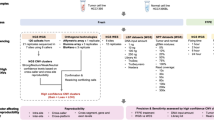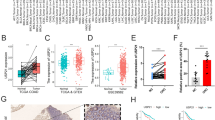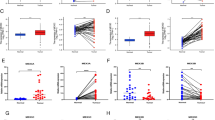Abstract
Cadherins (CDHs) are important in maintenance of cell adhesion and polarity, alterations of which contribute to tumorigenesis. Alterations of E-cadherin, a prototype CDH, have been reported in many cancers. However, alterations of unconventional CDHs, including CDH10, CDH24 and DCHS2 are largely unknown in cancers. Aim of this study was to explore whether CDH10, CDH24 and DCHS2 genes are mutated in gastric (GC) and colorectal cancers (CRC). In a public database, we found that CDH10, CDH24 and DCHS2 genes had mononucleotide repeats in the coding sequences that might be mutation targets in the cancers with microsatellite instability (MSI). We analyzed the mutations in 89 GC and 131 CRC (high MSI (MSI-H) or stable MSI/low MSI (MSS/MSI-L)) by single-strand conformation polymorphism analysis and DNA sequencing. We found six DCHS2, one CDH10 and one CDH24 frameshift mutations in them. All of the mutations were detected in cancers with MSI-H and there was a statistical difference in the frameshift mutation frequencies between the cancers with MSI-H (8/105) and MSS/MSI-L (0/115). The DCHS2 frameshift mutations were found in 8.8 % and 4.2 % of GC and CRC with MSI-H respectively. Our results show that unconventional CDH10, CDH24 and DCHS2 genes harbored frameshift mutations. These mutations might inactivate the cell adhesion-related functions and could be a feature of GC and CRC with MSI-H.

Similar content being viewed by others
References
Hulpiau P, van Roy F (2009) Molecular evolution of the cadherin superfamily. Int J Biochem Cell Biol 41:349–369
Angst BD, Marcozzi C, Magee AI (2001) The cadherin superfamily: diversity in form and function. J Cell Sci 114(Pt 4):629–941
Gooding JM, Yap KL, Ikura M (2004) The cadherin-catenin complex as a focal point of cell adhesion and signalling: new insights from three-dimensional structures. Bioessays 26:497–511
Kalluri R, Weinberg RA (2009) The basics of epithelial-mesenchymal transition. J Clin Invest 119:1420–1428
Tepass U, Truong K, Godt D et al (2000) Cadherins in embryonic and neural morphogenesis. Nat Rev Mol Cell Biol 1:91–100
Gottardi CJ, Wong E, Gumbiner BM (2001) E-cadherin suppresses cellular transformation by inhibiting beta-catenin signaling in an adhesion-independent manner. J Cell Biol 153:1049–1060
Hirohashi S (1998) Inactivation of the E-cadherin-mediated cell adhesion system in human cancers. Am J Pathol 153:333–339
Muta H, Noguchi M, Kanai Y et al (1996) E-cadherin gene mutations in signet ring cell carcinoma of the stomach. Jpn J Cancer Res 87:843–848
Williams MJ, Lowrie MB, Bennett JP et al (2005) Cadherin-10 is a novel blood–brain barrier adhesion molecule in human and mouse. Brain Res 1058:62–72
Walker MM, Ellis SM, Auza MJ et al (2008) The intercellular adhesion molecule, cadherin-10, is a marker for human prostate luminal epithelial cells that is not expressed in prostate cancer. Mod Pathol 21:85–95
Katafiasz BJ, Nieman MT, Wheelock MJ et al (2003) Characterization of cadherin-24, a novel alternatively spliced type II cadherin. J Biol Chem 278:27513–27519
Höng JC, Ivanov NV, Hodor P et al (2004) Identification of new human cadherin genes using a combination of protein motif search and gene finding methods. J Mol Biol 337:307–317
Imai K, Yamamoto H (2008) Carcinogenesis and microsatellite instability: the interrelationship between genetics and epigenetics. Carcinogenesis 29:673–680
Murphy K, Zhang S, Geiger T et al (2006) Comparison of the microsatellite instability analysis system and the Bethesda panel for the determination of microsatellite instability in colorectal cancers. J Mol Diagn 8:305–311
Kim YR, Oh JE, Kim MS et al (2010) Oncogenic NRF2 mutations in squamous cell carcinomas of oesophagus and skin. J Pathol 220:446–451
Yoo NJ, Kim HR, Kim YR et al (2012) Somatic mutations of the KEAP1 gene in common solid cancers. Histopathology 60:943–952
Je EM, Kim MR, Min KO et al (2012) Mutational analysis of MED12 exon 2 in uterine leiomyoma and other common tumors. Int J Cancer 131:E1044–1047
Birchmeier W, Behrens J (1994) Cadherin expression in carcinomas: role in the formation of cell junctions and the prevention of invasiveness. Biochim Biophys Acta 1198:11–26
Sato Y, Yoshizato T, Shiraishi Y et al (2013) Integrated molecular analysis of clear-cell renal cell carcinoma. Nat Genet 45:860–867
Barbieri CE, Baca SC, Lawrence MS et al (2012) Exome sequencing identifies recurrent SPOP, FOXA1 and MED12 mutations in prostate cancer. Nat Genet 44:685–689
Cancer Genome Atlas Network (2012) Comprehensive molecular characterization of human colon and rectal cancer. Nature 487:330-–337
Acknowledgments
This study was supported by a grant from National Research Foundation of Korea (2012R1A5A2047939 and 2012R1A1B3000458).
Author information
Authors and Affiliations
Corresponding author
Additional information
Chang Hyeok An and Eun Mi Je contributed equally to this work
Rights and permissions
About this article
Cite this article
An, C.H., Je, E.M., Yoo, N.J. et al. Frameshift Mutations of Cadherin Genes DCHS2, CDH10 and CDH24 Genes in Gastric and Colorectal Cancers with High Microsatellite Instability. Pathol. Oncol. Res. 21, 181–185 (2015). https://doi.org/10.1007/s12253-014-9804-8
Received:
Accepted:
Published:
Issue Date:
DOI: https://doi.org/10.1007/s12253-014-9804-8




